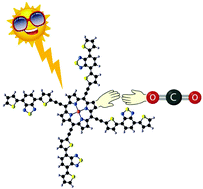Towards developing efficient metalloporphyrin-based hybrid photocatalysts for CO2 reduction; an ab initio study†
Abstract
A series of thiophene-based donor–acceptor–donor (D–A–D) oligomer substituted metalloporphyrins (MPors) with different 3d central metal-ions (M = Co, Ni, Cu, and Zn) were systematically investigated to screen efficient hybrid photocatalysts for CO2 reduction based on density functional theory (DFT) and time-dependent DFT simulations. Compared with base MPors, the newly designed hybrid photocatalysts have a lower bandgap energy, stronger and broader absorption spectra, and enhanced intermolecular charge transfer, exciton lifetime, and light-harvesting efficiency. Then, the introduction of D–A–D electron donor (ED) groups into the meso-positions of MPors is a promising method for the construction of efficient photocatalysts. According to the calculated adsorption distance, adsorption energy, Hirshfeld charge and electrostatic potential analysis, it was revealed that CO2 physically adsorbed on the designed photocatalyst surface. In addition, among the studied model systems the ZnPor(ED)4 catalyst with four D–A–D electron donors exhibits the best photocatalytic performance due to its broadest absorption spectra with λmax = 500.12 nm and the highest adsorption energy of about 26 kJ mol−1. Finally, the sensing ability of the ZnPor(ED)4-based multi-terminal molecular junction for CO2 gas detection is determined using Green's functions. The transmission plots of this molecular junction are barely changed due to the physical adsorption of CO2 on the molecular surface, leading to the low sensitivity of the device. We believe that such a theoretical design can provide a general approach for further experimental and computational studies of photocatalysts used in the CO2 reduction process.



 Please wait while we load your content...
Please wait while we load your content...